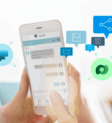Basic Resources Required to Build an Enterprise Chatbot

“BOTS ARE THE NEW APPS!” – MICROSOFT CEO, SATYA NADELLA
Enterprises today use numerous applications for diverse purposes. The different types of apps in an enterprise IT architecture typically include:
Productivity
ESS
LOB
ERP

Due to the constant increase in organizational data and changing business necessities, new apps emerge and employees need to constantly switch different apps for multiple purposes.
This continuous switching especially becomes a major hurdle for key decision-makers who need speedy access to pinpointed information.
This vigorous growth of enterprise apps also burdens the IT department which needs to ensure high-level security and the right authentication levels. Not to mention, three-quarters of enterprise applications have at least one vulnerability.
Chatbot (or bot) acts as an app manager by extracting the queried data from the organization’s core applications and sending it through the chosen and already-actively-used organizational messaging platform like Skype for Business, Microsoft Teams, Slack, Telegram etc.
Usually powered by Artificial Intelligence and Natural Language Processing, chatbots eliminate the need for specialist apps and act as a single point of contact to decision-makers.
The conversational interface of these bots allows employees to get the needed data by asking one question at a time right within their preferred messaging app.
While developing a new enterprise application is not a new concept, building a robust enterprise chatbot is still a journey less traveled.
THE FIRST STEP TOWARDS BUILDING AN ENTERPRISE BOT
– CREATE A BOT STRATEGY
Without strategy, execution is aimless – Morris Chang
Before delving into the actual part of this blog-post i.e basic resources to build an enterprise bot, it’s important to first discuss a bigger question –
“Why are you building the bot and how does it fit with your company’s goals”
Business leaders often struggle to identify different workplace challenges that can be effectively solved and automated with a bot. Gone are the days when the use cases of bots are limited to customer service.
Strategized properly, an AI bot can automate several mundane tasks in the enterprise, and also acts as a helpful digital assistant for different decision makers in multiple departments.
Based on the requirement and use cases, a structured process needs to be followed to convert requirements into a conversation design and then use it to train the chatbot and define the responses with the desired Tone of Voice.
Since its time-consuming and labour intensive task for IT leaders to explore the various use cases of enterprise AI bots themselves, Acuvate conducts AI chatbot consulting workshops.
These sessions are aimed to educate executives on the different use cases of enterprise chatbots and developing a customized bot strategy after assessing the organization’s needs.
Acuvate’s bot implementation procedure follows an agile methodology or what we call it as BDLC (Bot Development Lifecycle) Framework.
Based on the requirement and use cases, a structured process is followed to convert requirements into conversation design and then use these to train the chatbot and define the responses with the desired Tone of Voice.
At different stages in the lifecycle, a set of templates, tools, and processes are used to streamline activities involved and keep stakeholders updated.
Just like any other agile project, this is a sprint-based approach. Each sprint duration will be in the range of 4 to 5 weeks. Here’s a small peek at our typical 4-week sprint.
WEEK 1 | WEEK 2 | WEEK 3 | WEEK 4 | |
|---|---|---|---|---|
Activities |
|
|
|
|
Deliverables |
|
|
|
Framework
Just like bots, frameworks also are evolving everyday. Some of the latest frameworks provide toolkits which support different languages for bot development, portals for quick assembly and emulators for bot testing. As the complexity of the use case increases, the conversation needs to support thesaurus, taxonomies etc.
Natural Language understanding, processing and learning
An effective bot is one that is able to understand the user’s language and the context of conversation throughout the chat. While comprehending the language of user requires text and linguistic analysis i.e parts of speech tagging, phrase analysis etc. analyzing the context of conversation involves modelling the entities, intents, and actions of the user.
The bot should integrate with industry standard NLP services to provide a natural way for users to communicate with it. It is recommended that the bot platform must not be locked to a single NLP service or vendor. It should have the flexibility to switch to a different service if required. As the NLP and AI services across all vendors are constantly improving, this will give us the flexibility to choose the best NL services and integrate into the bot even in the future.
This is possible through cognitive service abstraction.
Cognitive Service Abstraction – This component provides an abstraction layer to industry standard AI & cognitive services across text, speech, vision (image) and custom machine learning algorithms. You will have the flexibility to choose and integrate the best Ai services as they mature. The abstraction layer ensures that the rest of your bot implementation will not be affected.
Conversational User Experience Design:
Conversational User Experience (CUX) Design is an important element of any good chatbot design. A well crafted conversational UX helps users achieve their goal in the shortest time with maximum end-user experience.
The design should make it easy for users to easily understand the functioning of bot and have an intelligent and helpful conversation with the bot.
A good CUX design should focus on the following aspects:
Conversations | Utterances | Best Practices |
|
|
|
Read More: A Quick Guide to Creating an Effective Conversational User Experience
Dialog development
The user engagement directly depends on how well the bot converses with the user. An effective bot should send natural language responses based on the inputs. Dialog development services include:
Obtaining the profiles of users
Retaining the context of the conversation
Improving user interaction by providing a User interface based on the inputs
Bot should be able to understand and remember the context of a conversation with a user. It should not let users repeat themselves and rather pick up information from the conversation and use that to provide better answers and a meaningful conversation.
Host channel
Host channel is the channel through which you host the conversation with a user. By providing suitable API support for bots, a channel can prove to be an excellent host for publishing custom bots. A few of the most notable chat applications like Slack, Skype, Skype for Business, Telegram etc. have started providing support for bots.
A few more categories to consider include visual recognition, language translation and multi-device support among others.
Analytics & Administration
Once the bot is deployed for end users, it’s important to keep a check on its performance and continue to refine its natural language understanding through further training.
Frequent analysis of the bot chats ensures a continuous refinement of the bot’s functioning. It is also recommended to have a robust reporting system and dashboards for getting detailed insights of the bot’s performance.
With an administration portal, bot administrators can conveniently
Manage and train the bot
Control the bot responses
Manage user access etc.
Security & User Permissions
The bot should be aware if a user is authorized and properly authenticated to chat with it. This ensures that the bot is able to provide the right set of relevant services for a particular user. The entire communication series between the bot and user should be encrypted using SSL based encryption.
The bot needs to accept conversations from valid user IDs which are authorized to chat with the bot. These IDs can be configured into the bot post deployment by an administrator.
These are just a few basic resources using which you can kick start your enterprise bot journey. However, to build a productive bot which can drive high business efficiency and value, we also need to consider several other business and technical aspects.
If you’d like to learn more about this topic, please feel free to get in touch with one of our experts for a personalized consultation.

Jagan Jami is the COO @ Acuvate Software. He heads the delivery unit at Acuvate which had delivered 100+ intranets to companies across the globe. Jagan has been working with global CIOs and other business heads and consulted them on Intranet evolution and current trends.







Jagan Jami